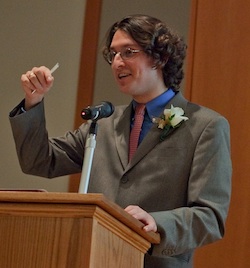By Diana Brement, JTNews Columnist
Devin Naar, Assistant Professor
Age: 29
Reading: “A lot of esoteric stuff” as well as “Eating Animals” by Jonathan Safran Foer
Inspired by: Our local Sephardic community
Professor Devin Naar’s enthusiasm is palpable and contagious, even over the phone.
The University of Washington’s Marsha & Jay Glazer Assistant Professor in Jewish Studies, a Sephardic history expert, has just finished his first year teaching in the history and Jewish studies departments.
“We raced through history,” he notes dryly of his 10-week survey of Jewish culture from the Bible to the 20th century. Modern Jewish history and a seminar about Jewish, Christian and Muslim interaction around the Mediterranean rounded out the year.
In that third class, Naar was able to focus on Salonika, his area of expertise. The northern Greek city was part of the Ottoman Empire for many centuries and “from 1492 to World War II, half the population of the city was Jewish, mostly Sephardic,” he says.
“The Jerusalem of the Balkans,” was a center of cultural, political and religious diversity, where Jewish exiles from around the world found refuge.
The community’s common language was Ladino, the Judeo-Spanish dialect that has existed since before the Inquisition, but that community was decimated by the Nazis — as were almost all Ladino-speaking communities of that time, leading to tremendous losses in Ladino literature and culture.
A faculty grant has given Naar time for two projects, completing his book on Salonika, an outgrowth of his Stanford University dissertation, and developing the Sephardic Studies Initiative, an effort “to collect, preserve and rejuvenate [our] rich Sephardic heritage,” he says.
Although Seattle may have the third largest Sephardic population in the country, “it’s probably one of the most well-organized,” Naar observes. It’s also the perfect place to launch the initiative’s pilot program, Seattle Sephardic Treasures, and Naar calls it “bashert [destiny], or kismet, as you would say in Ladino or Turkish,” that he ended up here.
With both academic and community components, Naar hopes to make the initiative a repository and resource center for Ladino documents, similar to the Yiddish Book Center. He launched it with a table at the Ezra Bessaroth Purim Bazaar earlier this year and continues to invite the community to “open their closets and drawers” and share their Ladino documents and books so they can be documented and digitized (www.jewdub.org/
seattle-sephardic-treasures). And look for a conference on the subject of Sephardic Jews and the Holocaust to be held here in the fall.
Calling it “a real grassroots” project, Naar credits Noam Pianko, head of the Althea & Sam Stroum Jewish Studies Program, for his support and “an amazing job” of thinking innovatively about what the department can offer both students and community.
A New Jersey native, Naar describes himself as “Ashkepharedi,” with roots in Salonika through his paternal great-grandfather, “the first rabbi of the Sephardic synagogue in New Jersey.” Naar attended that synagogue as a young child before his family moved and joined a Conservative synagogue, but “both those heritages [were] an important part of my life,” he says.
Certainly no one else he knew “had a picture of their great-grandfather who was wearing a fez and happened to be a rabbi,” he added.
Although he thought he might become a children’s book illustrator or an attorney — both, he notes, involve telling stories — his interest in his Sephardic heritage bloomed in college when, at Washington University in St. Louis, he became known as “the Sephardic kid” among his brothers at Alpha Epsilon Pi.
The busy Professor Naar is getting married shortly in Los Angeles by the same rabbi who presided over his Bar Mitzvah. He drew the cover of his wedding invitation, which incorporates both English and Ladino in Hebrew characters — the first, he thinks, to be printed this way since before the war.
In his free time Naar enjoys playing a little basketball. He and his fiancée Andrea Soroko enjoy cooking mostly vegetarian food, although they’ve added seafood to their diet since moving to Seattle.
A previous profile of Naar, by the way, appeared in these pages in July 2011.
